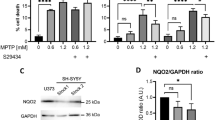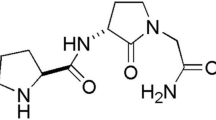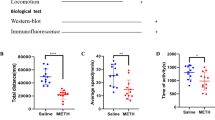Abstract
Dopaminergic cell loss in the mesencephalic substantia nigra is the hallmark of Parkinson’s disease and may be associated with abnormal oxidative metabolic activity. However, the delicate balance underlying dopamine decline and oxidative stress is still a matter of debate. The aim of this study was to analyze the possible modulation of dopamine D2 agonists and antagonists on MPP+ (1-methyl-4-phenyl-1,2,3,6-tetrahydropyridinium ion) -induced cellular death in differentiated and undifferentiated PC12 cells. Using colorimetric assays, western blots and reverse transcriptase-PCR, we demonstrated that two D2 agonists, bromocriptine and quinpirole, consistently increased MPP+-induced cytotoxicity in both differentiated and undifferentiated PC12 cells, whereas D2 antagonists did not modulate cell death. However, this increase in cellular death was reversed when bromocriptine or quinpirole were used in the presence of D2 antagonists. On the other hand, 1-2-[bis-(4-fluorophenyl)methoxy]ethyl-4-(3-phenylpropyl)piperazine (GBR 12909) a potent inhibitor of the dopamine transporter, partially reversed MPP+-induced cellular death and completely abolished the increase of cellular death induced by bromocriptine. Dopamine agonists and antagonists also modulate the expression of the dopamine transporter in PC12 cells; in particular, bromocriptine may alter MPP+ uptake by increasing DAT expression. We also show that, in our cellular paradigm, D2 receptor mRNA levels are more abundant that D3 mRNA levels and MPP+ and/or bromocriptine could not modulate D2 gene expression while D3 gene expression clearly decreased after MPP+ and/or bromocriptine treatment.
Similar content being viewed by others
References
Adams JD Jr and IN Odunze (1991) Biochemical mechanisms of 1-methyl-4-phenyl-1,2,3,6-tetrahydropyridine toxicity. Could oxidative stress be involved in the brain?Biochem. Pharmacol. 41, 1099–1105.
Akaneya Y, M Takahashi and H Hatanaka (1995) Involvement of free radicals in MPP+ neurotoxicity against rat dopaminergic neurons in culture.Neurosci. Lett. 193, 53–56.
Amantea D, R Russo, G Bagetta and MT Corasaniti (2005) From clinical evidence to molecular mechanisms underlying neuroprotection afforded by estrogens.Pharmacol. Res. 52, 119–132.
Bougria M, J Vitorica, J Cano and A Machado (1995) Implication of dopamine transporter system on 1-methyl-4-phenylpyridinium and rotenone effect in striatal synaptosomes.Eur. J. Pharmacol. 291, 407–415.
Bunzow JR, HH Van Tol, DK Grandy, P Albert, J Salon, M Christie, CA Machida, KA Neve and O Civelli (1988) Cloning and expression of a rat D2 dopamine receptor cDNA.Nature 336, 783–787.
Cassarino DS, CP Fall, TS Smith and JP Bennett Jr (1998) Pramipexole reduces reactive oxygen species productionin vivo andin vitro and inhibits the mitochondrial permeability transition produced by the parkinsonian neurotoxin methylpyridinium ion.J. Neurochem. 71, 295–301.
Chiba K, A Trevor and N Castagnoli Jr (1984) Metabolism of the neurotoxic tertiary amine, MPTP, by brain monoamine oxidase.Biochem. Biophys. Res. Commun. 120, 574–578.
Chu E, J Chu, RR Socci and TC Chu (2004) 7-OH-DPAT-induced inhibition of norepinephrine release in PC12 cells.Pharmacology 70, 130–139.
Coronas V, S Krantic, F Jourdan and E Moyse (1999) Dopamine receptor coupling to adenylyl cyclase in rat olfactory pathway: a combined pharmacological-radioautographic approach.Neuroscience 90, 69–78.
Cossette LJ, I Gaumond and MG Martinoli (2002) Combined effect of xenoestrogens and growth factors in two estrogen-responsive cell lines.Endocrine 18, 303–308.
Damon DH, PA D’Amore and JA Wagner (1990) Nerve growth factor and fibroblast growth factor regulate neurite outgrowth and gene expression in PC 12 cells via both protein kinase C- and cAMP-independent mechanisms.J. Cell. Biol. 110, 1333–1339.
Danzeisen R, B Schwalenstoecker, F Gillardon, E Buerger, V Krzykalla, K Klinder, L Schild, B Hengerer, AC Ludolph, C Dorner-Ciossek and L Kussmaul (2006) Targeted antioxidative and neuroprotective properties of the dopamine agonist pramipexole and its nondopaminergic enantiomer SND919CL2x [(+)2-amino-4,5,6,7-tetrahydro-6-L-propylamino-benzathiazole dihydrochloride].J. Pharmacol. Exp. Ther. 316, 189–199.
Decker T and ML Lohmann-Matthes (1988) A quick and simple method for the quantitation of lactate dehydrogenase release in measurements of cellular cytotoxicity and tumor necrosis factor (TNF) activity.J. Immunol. Meth. 115, 61–69.
Du Y, RC Dodel, KR Bales, R Jemmerson, E Hamilton-Byrd and SM Paul (1997) Involvement of a caspase-3-like cysteine protease in 1-methyl-4-phenylpyridinium-mediated apoptosis of cultured cerebellar granule neurons.J. Neurochem. 69, 1382–1388.
Dudley AJ, K Bleasby and CD Brown (2000) The organic cation transporter OCT2 mediates the uptake of beta-adrenoceptor antagonists across the apical membrane of renal LLC-PK(1) cell monolayers.Br. J. Pharmacol. 131, 71–79.
Fall CP and JP Bennett Jr (1999) Characterization and time course of MPP+ -induced apoptosis in human SH-SY5Y neuroblastoma cells.J. Neurosci. Res. 55, 620–628.
Fornai F, G Battaglia, M Gesi, F Orzi, F Nicoletti and S Ruggieri (2001) Dose-dependent protective effects of apomorphine against methamphetamine-induced nigrostriatal damage.Brain Res. 898, 27–35.
Gagne B, S Gelinas, G Bureau, B Lagace, C Ramassamy, K Chiasson, B Valastro and MG Martinoli (2003) Effects of estradiol, phytoestrogens, and Ginkgo biloba extracts against 1-methyl-4-phenyl-pyridine-induced oxidative stress.Endocrine 21, 89–95.
Gelinas S and MG Martinoli (2002) Neuroprotective effect of estradiol and phytoestrogens on MPP+-induced cytotoxicity in neuronal PC12 cells.J. Neurosci. Res. 70, 90–96.
Gelinas S, G Bureau, B Valastro, G Massicotte, F Cicchetti, K Chiasson, B Gagne, J Blanchet and MG Martinoli (2004) Alpha and beta estradiol protect neuronal but not native PC 12 cells from paraquat-induced oxidative stress.Neurotoxicity Res. 6, 141–148.
Geurts M, E Hermans, J Cumps and JM Maloteaux (1999) Dopamine receptor-modulated [35S]GTPgammaS binding in striatum of 6-hydroxydopamine-lesioned rats.Brain Res. 841, 135–142.
Gibb WR, B Costall, AM Domeney, ME Kelly and RJ Naylor (1988) The histological effects of intracerebral injection or infusion of MPTP (1-methyl-4-phenyl-1,2,3,6-tetrahydropyridine) and MPP+ (1-methyl-4-phenylpyridinium) in rat and mouse.Brain Res. 461, 361–366.
Gonzalez-Polo RA, A Mora, N Clemente, G Sabio, F Centeno, G Soler and JM Fuentes (2001) Mechanisms of MPP(+) incorporation into cerebellar granule cells.Brain Res. Bull. 56, 119–123.
Greene LA and AS Tischler (1976) Establishment of a noradrenergic clonal line of rat adrenal pheochromocytoma cells which respond to nerve growth factor.Proc. Natl. Acad. Sci. USA 73, 2424–2428.
Grosset K, F Needleman, G Macphee and D Grosset (2004) Switching from ergot to nonergot dopamine agonists in Parkinson’s disease: a clinical series and five-drug dose conversion table.Mov. Disord. 19, 1370–1374.
Grunblatt E, S Mandel, T Berkuzki and MB Youdim (1999a) Apomorphine protects against MPTP-induced neurotoxicity in mice.Mov. Disord. 14, 612–618.
Grunblatt E, S Mandel, M Gassen and MB Youdim (1999b) Potent neuroprotective and antioxidant activity of apomorphine in MPTP and 6-hydroxydopamine induced neurotoxicity.J. Neural Transm. Suppl. 55, 57–70.
Gu M, MM Iravani, JM Cooper, D King, P Jenner and AH Schapira (2004) Pramipexole protects against apoptotic cell death by nondopaminergic mechanisms.J. Neurochem. 91, 1075–1081.
Gutteridge JMC and B Halliwell (1996) Oxidative stress, brain iron and neurodegeneration. Basic principles. In:Neurodegeneration and Neuroprotection in Parkinson’s Disease (Jenner P, Ed.) (Academic Press:London), pp 1–21.
Hall DA and PG Strange (1997) Evidence that antipsychotic drugs are inverse agonists at D2 dopamine receptors.Br. J. Pharmacol. 121, 731–736.
Hall ED, PK Andrus, JA Oostveen, JS Althaus and PF VonVoigtlander (1996) Neuroprotective effects of the dopamine D2/D3 agonist pramipexole against postischemic or methamphetamine-induced degeneration of nigrostriatal neurons.Brain Res. 742, 80–88.
Iida M, I Miyazaki, K Tanaka, H Kabuto, E Iwata-Ichikawa and N Ogawa (1999) Dopamine D2 receptor-mediated antioxidant and neuroprotective effects of ropinirole, a dopamine agonist.Brain Res. 838, 51–59.
Itano Y, Y Kitamura and Y Nomura (1994) 1-Methyl-4-phenylpyridinium (MPP+)-induced cell death in PC12 cells: inhibitory effects of several drugs.Neurochem. Int. 25, 419–424.
Javitch JA, RJ D’Amato, SM Strittmatter and SH Snyder (1985) Parkinsonism-inducing neurotoxin, N-methyl-4-phenyl-1,2,3,6 -tetrahydropyridine: uptake of the metabolite N-methyl-4-phenylpyridine by dopamine neurons explains selective toxicity.Proc. Natl. Acad. Sci. USA 82, 2173–2177.
Jenner P (1998) Oxidative mechanisms in nigral cell death in Parkinson’s disease.Mov. Disord. 13 Suppl. 1, 24–34.
Jorgensen OS and C Richter-Landsberg (1983) D2-protein in PC12 pheochromocytoma cells after nerve growth factor stimulation.Neuroscience 9, 665–672.
Jost WH (2004) Ropinirole: current status of the studies.J. Neurol. 251 Suppl. 6, VI/13–18.
Joyce JN, S Presgraves, L Renish, S Borwege, T Osredkar, D Hagner, M Replogle, M PazSoldan and MJ Millan (2003) Neuroprotective effects of the novel D3/D2 receptor agonist and antiparkinson agent, S32504,in vitro against 1-methyl-4-phenylpyridinium (MPP+) andin vivo against 1-methyl-4-phenyl-1,2,3,6-tetrahydropyridine (MPTP): a comparison to ropinirole.Exp. Neurol. 184, 393–407.
Kadota T, T Yamaai, Y Saito, Y Akita, S Kawashima, K Moroi, N Inagaki and K Kadota (1996) Expression of dopamine transporter at the tips of growing neurites of PC12 cells.J. Histochem. Cytochem. 44, 989–996.
Kimmel HL, AR Joyce, FI Carroll and MJ Kuhar (2001) Dopamine D1 and D2 receptors influence dopamine transporter synthesis and degradation in the rat.J. Pharmacol. Exp. Ther. 298, 129–140.
Kitamura Y, Y Kohno, M Nakazawa and Y Nomura (1997) Inhibitory effects of talipexole and pramipexole on MPTPinduced dopamine reduction in the striatum of C57BL/6N mice.Jpn. J. Pharmacol. 74, 51–57.
Kitayama S, C Mitsuhata, S Davis, JB Wang, T Sato, K Morita, GR Uhl and T Dohi (1998) MPP+ toxicity and plasma membrane dopamine transporter: study using cell lines expressing the wildtype and mutant rat dopamine transporters.Biochim. Biophys. Acta 1404, 305–313.
Kobayashi S, L Conforti, WH Zhu, D Beitner-Johnson and DE Millhorn (1999) Role of the D2 dopamine receptor in molecular adaptation to chronic hypoxia in PC 12 cells.Pflugers Arch. 438, 750–759.
Kostrzewa RM, P Nowak, JP Kostrzewa, RA Kostrzewa and R Brus (2005) Peculiarities of L-DOPA treatment of Parkinson’s disease.Amino Acids 28, 157–164.
Langston JW, P Ballard, JW Tetrud and I Irwin (1983) Chronic Parkinsonism in humans due to a product of meperidine-analog synthesis.Science 219, 979–980.
Le WD and J Jankovic (2001) Are dopamine receptor agonists neuroprotective in Parkinson’s disease?Drugs Aging 18, 389–396.
Le WD, J Jankovic, W Xie and SH Appel (2000) Antioxidant property of pramipexole independent of dopamine receptor activation in neuroprotection.J. Neural Transm. 107, 1165–1173.
Lee SY, TY Ha, DJ Son, SR Kim and JT Hong (2005) Effect of sesaminol glucosides on beta-amyloid-induced PC12 cell death through antioxidant mechanisms.Neurosci. Res. 52, 330–341.
Levi MS and MA Brimble (2004) A review of neuroprotective agents.Curr. Med. Chem. 11, 2383–2397.
Lin C, P McGonigle and PB Molinoff (1987) Characterization of D-2 dopamine receptors in a tumor of the rat anterior pituitary gland.J. Pharmacol. Exp. Ther. 242, 950–956.
Liu LX, LH Burgess, AM Gonzalez, DR Sibley and LA Chiodo (1999) D2 S, D2 L, D3, and D4 dopamine receptors couple to a voltage-dependent potassium current in N18TG2 x mesencephalon hybrid cell (MES-23.5) via distinct G proteins.Synapse 31, 108–118.
Liu XH, H Kato, T Chen, K Kato and Y Itoyama (1995) Bromocriptine protects against delayed neuronal death of hippocampal neurons following cerebral ischemia in the gerbil.J. Neurol. Sci. 129, 9–14.
Liu YF, KH Jakobs, MM Rasenick and PR Albert (1994) G protein specificity in receptor-effector coupling. Analysis of the roles of G0 and G12 in GH4C1 pituitary cells.J. Biol. Chem. 269, 13880–13886.
Lledo A (2000) Dopamine agonists: the treatment for Parkinson’s disease in the XXI century?Parkinsonism Relat. Disord. 7, 51–58.
Marin R, B Guerra, R Alonso, CM Ramirez and M Diaz (2005) Estrogen activates classical and alternative mechanisms to orchestrate neuroprotection.Curr. Neurovasc. Res. 2, 287–301.
Martin A and M Clynes (1991) Acid phosphatase: endpoint forin vitro toxicity tests.In vitro Cell Dev. Biol. 27A, 183–184.
McGavin JK and KL Goa (2002) Aripiprazole.CNS Drugs 16, 779–786; discussion 787-778.
Muralikrishnan D and KP Mohanakumar (1998) Neuroprotection by bromocriptine against 1-methyl-4-phenyl-1,2,3,6-tetrahydropyridine-induced neurotoxicity in mice.FASEB J. 12, 905–912.
Meiergerd SM, TA Patterson and JO Schenk (1993) D2 receptors may modulate the function of the striatal transporter for dopamine: kinetic evidence from studiesin vitro andin vivo.J. Neurochem. 61, 764–767.
Melamed E, G Friedberg and J Zoldan (1999) Psychosis: impact on the patient and family.Neurology 52, S14-S16.
Mytilineou C (2001) Mechanism of MPTP neurotoxicity. In:Mechanisms of Degeneration and Protection of the Dopaminergic System (Segura-Aguilar J, Ed.) (FP Graham Publ.:Johnson City, TN), pp 131–148.
Navan P, LJ Findley, MB Undy, RK Pearce and PG Bain (2005) A randomly assigned double-blind cross-over study examining the relative anti-parkinsonian tremor effects of pramipexole and pergolide.Eur. J. Neurol. 12, 1–8.
Neve KA, JK Seamans and H Trantham-Davidson (2004) Dopamine receptor signaling.J. Recept. Signal Transduct. Res. 24, 165–205.
Newman-Tancredi A, D Cussac, V Audinot, JP Nicolas, F De Ceuninck, JA Boutin and MJ Millan (2002) Differential actions of antiparkinson agents at multiple classes of monoaminergic receptor. II. Agonist and antagonist properties at subtypes of dopamine D2-like receptor and α1/α2-adrenoceptor.J. Pharmacol. Exp. Ther. 303, 805–814.
O’Neill MJ, CA Hicks, MA Ward, GP Cardwell, JM Reymann, H Allain and D Bentue-Ferrer (1998) Dopamine D2 receptor agonists protect against ischaemia-induced hippocampal neurodegeneration in global cerebral ischaemia.Eur. J. Pharmacol. 352, 37–46.
Pan T, W Xie, J Jankovic and W Le (2005) Biological effects of pramipexole on dopaminergic neuron-associated genes: relevance to neuroprotection.Neurosci. Lett. 377, 106–109.
Parker SG, P Raval, S Yeulet and RJ Eden (1994) Tolerance to peripheral, but not central, effects of ropinirole, a selective dopamine D2-like receptor agonist.Eur. J. Pharmacol. 265, 17–26.
Pothos EN, S Przedborski, V Davila, Y Schmitz and D Sulzer (1998) D2-Like dopamine autoreceptor activation reduces quantal size in PC12 cells.J. Neurosci. 18, 5575–5585.
Presgraves SP, S Borwege, MJ Millan and JN Joyce (2004) Involvement of dopamine D2/D3 receptors and BDNF in the neuroprotective effects of S32504 and pramipexole against 1-methyl-4-phenylpyridinium in terminally differentiated SHSY5Y cells.Exp. Neurol. 190, 157–170.
Przedborski S and M Vila (2003) The 1-methyl-4-phenyl-1,2,3,6-tetrahydropyridine mouse model: a tool to explore the pathogenesis of Parkinson’s disease.Ann. NYAcad. Sci. 991, 189–198.
Riederer P, J Sian and M Gerlach (2000) Is there neuroprotection in Parkinson syndrome?J. Neurol. 247 Suppl. 4, IV/8–11.
Roehm NW, GH Rodgers, SM Hatfield and AL Glasebrook (1991) An improved colorimetric assay for cell proliferation and viability utilizing the tetrazolium salt XTT.J. Immunol. Methods 142, 257–265.
Rousseau J, L Cossette, S Grenier and MG Martinoli (2002) Modulation of prolactin expression by xenoestrogens.Gen. Comp. Endocrinol. 126, 175–182.
Sawada H, M Ibi, T Kihara, M Urushitani, A Akaike, J Kimura and S Shimohama (1998) Dopamine D2-type agonists protect mesencephalic neurons from glutamate neurotoxicity: mechanisms of neuroprotective treatment against oxidative stress.Ann. Neurol. 44, 110–119.
Schapira AH (2002) Neuroprotection and dopamine agonists.Neurology 58, S9-S18.
Schapira AH (2003) Neuroprotection in PD - a role for dopamine agonists?Neurology 61, S34-S42.
Schapira AH and CW Olanow (2004) Neuroprotection in Parkinson disease: mysteries, myths, and misconceptions.JAMA 291, 358–364.
Schmittgen TD and BA Zakrajsek (2000) Effect of experimental treatment on housekeeping gene expression: validation by real time, quantitative RT-PCR.J. Biochem. Biophys. Methods 46, 69–81.
Segura Aguilar J and RM Kostrzewa (2004) Neurotoxins and neurotoxic species implicated in neurodegeneration.Neurotoxicity Res. 6, 615–630.
Sharma JC, L Macnamara, M Hasoon and M Vassallo (2004) Diagnostic and therapeutic value of apomorphine in Parkinsonian patients.Int. J. Clin. Pract. 58, 1028–1032.
Stonehouse AH and FS Jones (2005) Bromocriptine and clozapine regulate dopamine D2 receptor gene expression in the mouse striatum.J. Mol. Neurosci. 25, 29–36.
Szekeres J, AS Pacsa and B Pejtsik (1981) Measurement of lymphocyte cytotoxicity by assessing endogenous alkaline phosphatase activity of the target cells.J. Immunol. Meth. 40, 151–154.
Tischler AS, RL Perlman, GM Morse and BE Sheard (1983) Glucocorticoids increase catecholamine synthesis and storage in PC 12 pheochromocytoma cell cultures.J. Neurochem. 40, 364–370.
Toran-Allerand CD (2004) Estrogen and the brain: beyond ERalpha and ER-beta.Exp. Gerontol. 39, 1579–1586.
Wang C, DC Buck, R Yang, TA Macey and KA Neve (2005) Dopamine D2 receptor stimulation of mitogen-activated protein kinases mediated by cell type-dependent transactivation of receptor tyrosine kinases.J. Neurochem. 93, 899–909.
Yamamoto M (1998) Do dopamine agonists provide neuroprotection?Neurology 51, S10-S12.
Youdim MB, E Grunblatt and S Mandel (1999) The pivotal role of iron in NF-kappa B activation and nigrostriatal dopaminergic neurodegeneration. Prospects forneuroprotection in Parkinson’s disease with iron chelators.Ann. NYAcad. Sci. 890, 7–25.
Zou L, J Jankovic, DB Rowe, W Xie, SH Appel and W Le (1999) Neuroprotection by pramipexole against dopamine- and levodopa-induced cytotoxicity.Life Sci. 64, 1275–1285.
Author information
Authors and Affiliations
Corresponding author
Rights and permissions
About this article
Cite this article
Chiasson, K., Daoust, B., Levesque, D. et al. Dopamine D2 agonists, bromocriptine and quinpirole, increase MPP+-induced toxicity in PC12 cells. neurotox res 10, 31–42 (2006). https://doi.org/10.1007/BF03033332
Received:
Revised:
Issue Date:
DOI: https://doi.org/10.1007/BF03033332




